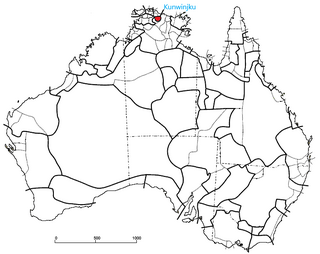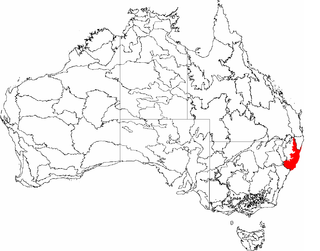
The Ngarrindjeri people are the traditional Aboriginal Australian people of the lower Murray River, eastern Fleurieu Peninsula, and the Coorong of the southern-central area of the state of South Australia. The term Ngarrindjeri means "belonging to men", and refers to a "tribal constellation". The Ngarrindjeri actually comprised several distinct if closely related tribal groups, including the Jarildekald, Tanganekald, Meintangk and Ramindjeri, who began to form a unified cultural bloc after remnants of each separate community congregated at Raukkan, South Australia.

Kuringgai is an ethnonym referring to an Indigenous Australian people who once occupied the territory between the southern borders of the Gamilaraay and the area around Sydney, and a historical people with its own distinctive language, located in part of that territory.
The Bigambul people are an Aboriginal Australian people of the Northern Tablelands and Border Rivers regions of New South Wales and Queensland.

The Bundjalung people, also spelled Bunjalung, Badjalang and Bandjalang, are Aboriginal Australians who are the original custodians of a region from around Grafton in northern coastal New South Wales to Beaudesert in south-east Queensland. The region is located approximately 550 kilometres (340 mi) northeast of Sydney and 100 kilometres (62 mi) south of Brisbane that now includes the Bundjalung National Park.
The Wandandian are an Aboriginal Australian people of the South Coast of New South Wales with connections to the Yuin and Tharawal nations.

The Kunwinjku people are an Australian Aboriginal people, one of several groups within the Bininj people, who live around West Arnhem Land to the east of Darwin, Northern Territory. Kunwinjku people generally refer to themselves as "Bininj" in much the same way that Yolŋu people refer to themselves as "Yolŋu".

The Dadi Dadi or Tatitati are an Australian Aboriginal people whose traditional lands are located along the southern banks of the Murray River in Victoria Australia.
The Maraura or Marrawarra people are an Aboriginal group whose traditional lands are located in Far West New South Wales and South Australia, Australia.
The Anēwan, also written Anaiwan and Anaywan, are an Aboriginal Australian people whose traditional territory spans the Northern Tablelands in New South Wales.

The Djangadi people, also spelt Dhungatti, Dainggati, Tunggutti or Dunghutti are an Aboriginal Australian people resident in the Macleay Valley of northern New South Wales.
The Barungguan are an Aboriginal Australian people of the Cape York Peninsula of Northern Queensland. The name is associated with three languages: Ganganda, Umpithamu and Morrobolam.
The Ngamba are an Australian Aboriginal people of New South Wales.
The Barindji, also written Parrintyi, are an indigenous Australian people of the state of New South Wales. They are to be distinguished from the Paaruntyi, who spoke a similar language but whom they called the spitting people.
The Jarildekald people, also known as Yarilde or Yaralde, are an Aboriginal Australian people of South Australia originating on the eastern side of Lake Alexandrina and the Murray River.
The Ngintait, or Ngindadj, are an Australian Aboriginal peoples of the northwest corner of the state of Victoria, and partly in South Australia. 9 people, all of one family, claim descent from the tribe, which was dispersed in the 19th century.
The Muruwari, also spelt Murawari, Murawarri, Murrawarri and other variants, are an Aboriginal Australian people of the state of New South Wales and the southwestern area of Queensland.
The Tjial were an indigenous Australian people of the Northern Territory who are now extinct.
The Banbai are an Indigenous Australian people of New South Wales.
The Kwiambal are an Aboriginal Australian people of New South Wales.
The Kula, also known as the Kurnu, were an indigenous Australian people of the state of New South Wales.